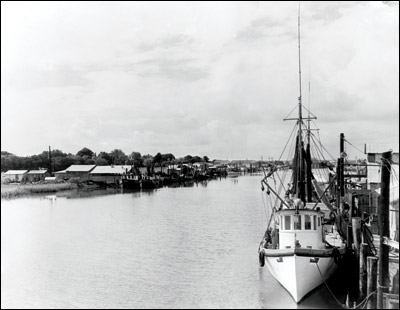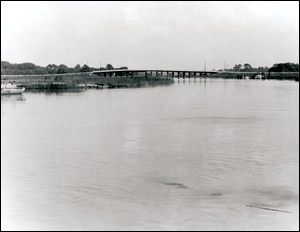Shem Creek, Mount Pleasant, SC
 Shem Creek has always been a working creek. It fed the Sewee Indians and ferried the father of our country safely across the harbor. It powered saw mills and rice mills and served up turtles whose meat won acclaim at fine restaurants in the Northeast.
Shem Creek has always been a working creek. It fed the Sewee Indians and ferried the father of our country safely across the harbor. It powered saw mills and rice mills and served up turtles whose meat won acclaim at fine restaurants in the Northeast.
It pumped money into Mount Pleasant’s economy with every net full of shrimp that its trawlers hauled back to the docks. And it worked magic for children, opening its arms to generations of little boys and girls who paddled into the creek holes, imaginations brimming, searching for adventure and buried treasures.
Shem Creek is still a working creek today, although much of the work has changed. It still feeds people, but today they’re mostly guests at the restaurants alongside the docks. Boats still come and go, but today the watercraft is more recreational than commercial.
Yet despite changing tides and times, Shem Creek still provides a livelihood, a playground and a sense of place. It’s the village’s touchstone — a picture-postcard place that still and always captures the heart and soul of Mount Pleasant.
Bricks, buckets, ferries and fleets.
The Indians are thought to have called it Shemee, possibly for a small tribe that lived on its banks. Shem Creek, whose head is near present-day Bowman Road, was commonly known in the 1700s by the name of the men who owned the land alongside it. It was Sullivan’s Creek (for Capt. Florence O’Sullivan, the patriot for whom Sullivan’s Island is named), Dearsley’s Creek (for George Dearsley, thought to have been one of the first shipbuilders on the creek) and Parris Creek (after Alexander Parris, who also owned land near Beaufort where the Parris Island U.S. Marine facilities are today).
Shipbuilding made Shem Creek a working creek, but it was far from the only activity there. Peter Villepontoux ran a lime kiln on the creek in the 1740s to supply the growing number of brickyards in the Lowcountry. Between 1745 and the start of the Civil War in 1861, more than 50 brickyards had operations on the Wando and Cooper rivers.
"More than two decades after the war ended, the modern seafood and boat building industries on Shem Creek were born..."
Ferry service made Shem Creek a hub of business as well. In 1770, Englishman Andrew Hibben bought a charter to run a ferry from the south side of Shem Creek to Charleston. Hibben’s Ferry was the first to connect Haddrell’s Point (the name given to the Old Village area after colonist George Haddrell) with the city of Charleston; other ferries had run from Hobcaw Creek. Hibben charged 33 cents for passengers, 21 cents for horned cattle, 75 cents for two-wheeled carriages and $1.75 for four-wheeled carriages.
In 1791, when President George Washington visited the South Carolina Lowcountry as part of his “Southern Tour,” Major Peter Bocquet provided him with a special barge that was refurbished and lengthened at Pritchard’s Shipyard on Hobcaw Creek. A dozen captains — one from each of the 12 American ships anchored in Charleston Harbor at the time — were invited to man the oars for the president’s crossing of the channel. A flotilla accompanied the presidential barge across the harbor, with crowds cheering and bands on several vessels providing music for the celebration.
In 1795, millwright and inventor Jonathan Lucas built a combination rice mill/saw mill on Shem Creek — the first water-driven rice mill in the area. The man and his work live on in the names of the thoroughfares along the creek — Mill Street and Lucas Street. Lucas’s mill was on the site of an earlier mill called Greenwich Mill, built by landowner Jonathan Scott. In the mid-1800s, John Hamlin’s Mount Pleasant Bucket Factory on the south side of the creek, in the area of present-day Live Oak Drive and Bennett Street, supplied not only buckets, but painted and unpainted pine, cypress, assorted lumber, and lathes as well.
War on the creek
The Civil War touched Shem Creek, just as it did the rest of the Charleston area. In the early 1860s, workers at Jones Shipyard on the creek had built a steamer called The Planter that owner F.M. Jones intended for use by nearby plantations. The vessel was instead put into service as a blockade runner for the Confederacy because of its shallow draft and speed. On May 13, 1862, while the vessel’s white officers were ashore, The Planter’s black quartermaster, Robert Smalls, and the rest of the all-black crew saw their opportunity and seized it. Smalls and his fellow sailors steered the ship out to meet Union vessels at the mouth of the harbor and were later rewarded for their daring.
At the time of the war, there was a grist mill on Shem Creek in the area that is now the Shemwood II subdivision. The mill ground rice and corn grown on local plantations. In February 1865, Mount Pleasant’s intendant (mayor), Henry Slade Tew, wrote a letter to his daughter telling her of the ill fate that befell the mill:
“I heard that orders had been given to burn the mill and contents, and about 1,200 bushels rough rice of which near 200 was my own, and I had also the stores for the poor in it. I regarded this as a wanton act of cruelty, as ours was an isolated community having no local source of supply, and all that was in the mill would not have afforded more than would suffice to feed them a month or two, and the destruction of the mill itself would deprive the people of a means of having any rice beat or corn ground, and must cause great suffering.”
Tew went to mill to try to stop the burning, appealing personally to Capt. C.P. Bolton and his cavalry as they approached bearing torches. “He (Bolton) admitted the cruelty of the act, knew from his long service at this post that the mill was the only source for the inhabitants to prepare their grain for food, but his orders compelled him to destroy it, and fire was accordingly applied, and the devilish act, I must call it, accomplished.”
Terrapins and trawlers
More than two decades after the war ended, the modern seafood and boat building industries on Shem Creek were born. In 1890, William Hale was operating an oyster factory on the creek, and in 1895, Capt. Robert Holman Magwood bought the Mount Pleasant Boat Building Co., docking his boats there and also operating a turtle crawl. The “Cooter Pen” shipped live diamondback terrapins to the larger cities in the Northeast, where they appeared on the menus of the finest hotels.
By the 1930s, though, shrimping and boat building were the major industries on the creek. The Darby family bought Mount Pleasant Boat Building in 1921 and the business thrived, specializing in engine installation, repairs and equipment sales as well as construction. When the company closed in 1990, the boat building business ceased on the creek.
 The shrimping industry continues at Shem Creek, although it faces pressure from cheap foreign imports, development on the creek, and the lack of ready supplies of two critical ingredients for the trawlers — ice and fuel. In the 1930s, Capt. William C. Magwood introduced the first powered trawler on the creek, the Skipper, and the Magwood family today is still a staple of the local seafood business. Also a fixture on the creek is Mount Pleasant Seafood, established in 1945 by W.D. Toler. His son-in-law, Rial Fitch, has owned the business since 1975 and has had a front-row seat for the changes on the creek.
The shrimping industry continues at Shem Creek, although it faces pressure from cheap foreign imports, development on the creek, and the lack of ready supplies of two critical ingredients for the trawlers — ice and fuel. In the 1930s, Capt. William C. Magwood introduced the first powered trawler on the creek, the Skipper, and the Magwood family today is still a staple of the local seafood business. Also a fixture on the creek is Mount Pleasant Seafood, established in 1945 by W.D. Toler. His son-in-law, Rial Fitch, has owned the business since 1975 and has had a front-row seat for the changes on the creek.
“The biggest change I’ve seen is the growth and upcropping of the restaurants,” Fitch says. “Originally there was just the Lorelei, then the Trawler, and then the others started coming — RB’s, The Barge. Down at the other end there’s Shem Creek Bar and Grill, and next to them — I can’t even remember all the others.
“Right behind that is the change from having all-commmercial and all-working boats to so many recreational and pleasure boats,” he says. “There used to be from 100 to 120 shrimp trawlers that frequented the creek at different times and unloaded between Simmons Seafood, Mount Pleasant Seafood, the Magwoods and all the different docks. Now there are probably 20 to 25. There are still a lot of people who go out on the creek to make a living, but it’s not as much a commercial creek as it was.”
Fitch grew up in downtown Charleston. “My earliest recollection of Shem Creek is coming across on the way to the Isle of Palms to see my aunt who lived over there, and every time you went across you could smell the seafood. I don’t remember seeing all the boats or anything else, but I remember you could smell the seafood.”
Like many longtime residents, Fitch recalls the shrimp house or “heading house” on the creek, where shrimp were processed before being sold. “It closed before Hugo, I’d say in the early ’80s, but in the late ’70s it was still real vibrant,” says Fitch. “There was what they called the Big White Truck, and it used to ride around and pick up the headers and bring them to the shrimp house, and then at 12, 1, 2 o’clock in the morning, they’d load everybody back up and take them home and do it all again the next day. That was seven days a week during the shrimp season.”
There were jobs there by the hundreds, but the pay was poor. “The headers got just pennies a pound — I think it was 10 cents a pound when they closed,” he says. “You’d head 100 pounds of shrimp and end up with $10.”
In 2002, the Town of Mount Pleasant appointed a special Shem Creek Management Committee to “determine a vision and outline issues of importance to the future of Shem Creek.” After several months spent gathering opinions and information from business owners, residents, environmental experts and others with an interest in the creek, the group issued its report. The conclusion? Simply this: “Overwhelmingly, the consensus was that the character of the creek remain as it is — natural, water-dependent, charming — a ‘working’ creek.”
Which is what Shem Creek always has been — and, one way or another, always should be.
